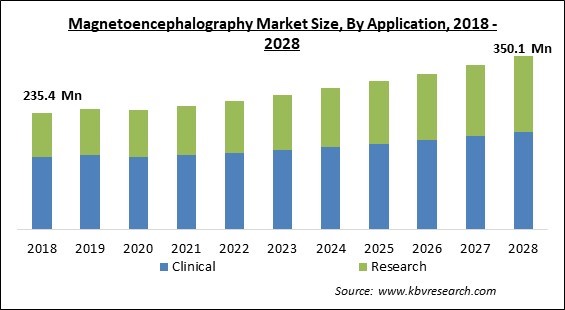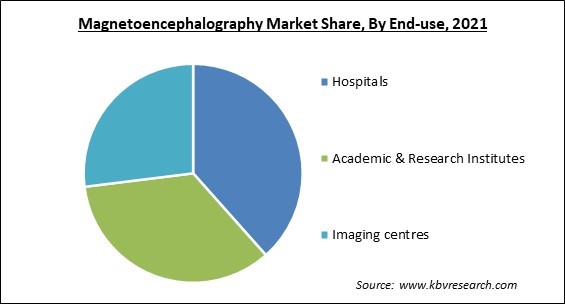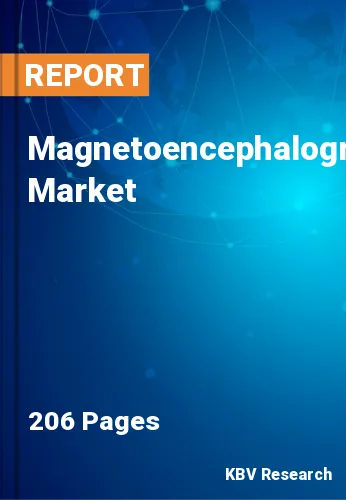The Global Magnetoencephalography Market size is expected to reach $350.1 million by 2028, rising at a market growth of 5.1% CAGR during the forecast period.
The magnetic field measurement created by the electrical activity of neurons is referred to as magnetoencephalography, abbreviated as MEG. In most cases, magnetic resonance imaging is also performed alongside it to get the result known as magnetic source imaging. The superconducting quantum interference detector, which functions similarly to a very sensitive magnetic field meter, is the piece of technology that has been instrumental in recording these extremely minute magnetic fields.

The MEG is housed in a chamber that has been magnetically insulated so that the magnetic noise from the environment may be reduced. Magnetometers and/or gradiometers are the types of sensors used to record magnetic fields. There is no disruption to the MEG fields as they travel through the skull. MEG has this major benefit over electroencephalography, which is a significant advantage. In addition, MEG gives a high resolution both spatially and temporally.
The term "magnetoencephalography" (MEG) refers to measuring the magnetic fields produced when electric currents flow through the brain. The magnetic field measurements fall somewhere in the femto-tesla to pico-tesla range. The time of neural activity can be resolved with a very high level of precision using MEG. This is a test that is not intrusive in any way.
MEG is a straightforward method of measuring brain activity and has a very high resolution in terms of time. In addition to that, the spatial resolution is relatively high. In order to provide a comprehensive view of the brain's structure, magnetic resonance imaging (MRI) and magnetoencephalography (MEG) are often used in conjunction with one another. Magnetic source imaging is the name given to the process that combines MRI and MEG (MSI). At this time, the only clinical applications that have been authorized for its usage in the United States of America are those involving epilepsy surgery and pre-operative brain mapping. In the United States, epilepsy centers are affiliated with most clinical MEG facilities.
The rapid spread of COVID-19 has had a detrimental effect on the economy of the whole globe. The spread of the new coronavirus substantially impacts the healthcare business. This is because the majority of healthcare staff were preoccupied with attending to COVID-19 patients. As a direct consequence of these constraints, the supply chains for various medical technology and equipment came to a standstill. In addition, the medical operations that were deemed to be of lesser importance were delayed during the first few years of the programme. As a consequence of this, the market for magnetoencephalography has seen slowed growth.
According to the World Health Organization (WHO), by the year 2030, one in six persons around the globe will be at least 60 years old. The percentage of the world's population that is 60 years old or older is expected to rise from 1 billion in the year 2020 to 1.4 billion in the year 2050. The number of persons aged 60 and older throughout the globe is expected to more than quadruple by the year 2050. (2.1 billion). It is anticipated that the population of people who are 80 years old or older will reach a total of 426 million between 2020 and 2050. Although nations with higher incomes were the first to experience what is now known as population aging (a movement in the age distribution of a country's population toward older ages), it is currently low- and middle-income countries that are suffering the most significant change as a result of this trend.
The increase in the number of investments made in the healthcare sector by the governments of a variety of nations, as well as the quantity of those investments, is one of the primary reasons driving the growth of the market. It is projected that more emerging countries will have better access to higher-quality healthcare due to the rapid economic growth of these nations and the rising expenses of healthcare. This is seen as a promising sign of growth for the surgical planning software market, which is expanding. As a result of the growing prevalence of health problems in these countries, there has been an uptick in demand for various treatments and equipment.
However, MEG is rather expensive and needs liquid helium to keep its superconducting equipment in working order. In comparison to the tens of thousands and hundreds of thousands of MRI and EEG sites worldwide, there are just a relative handful of MEG laboratories. The MEG technology is less accessible to the general public due to its high price and limited availability. Several options than MEG can be chosen from, each of which is much more beneficial and somewhat more affordable.
Based on application, the magnetoencephalography market is classified into clinical and research. In 2021, the research segment accounted for a significant revenue share in the magnetoencephalography market. A magnetoencephalography (MEG) device can record brain activity by detecting and amplifying attractive signals discharged by the brain. Additionally, a MEG device does not emit radiation or generate attractive fields in its surrounding environment.
The clinical segment of the magnetoencephalography market is further subdivided into dementia, autism, schizophrenia, multiple sclerosis, stroke, epilepsy, and others. In 2021, the dementia segment acquired the substantial revenue share of the magnetoencephalography market. During the multidisciplinary conference, the findings from the MEG visual analysis are utilized as a supporting diagnostic tool alongside other diagnostic procedure. This is accomplished by linking the results to the clinical differential diagnosis that the neurologist has developed for the patient.
Based on the end-use, the magnetoencephalography market is categorized into hospitals, imaging centers, and research & academic institutes. In 2021, the imaging centers segment accounted for a significant portion of the total revenue generated in the magnetoencephalography market. It is anticipated that the sector will continue to advance over the projection period due to low scan prices, reduced wait times, the participation of diagnostic accrediting bodies, and an expanding reimbursement structure.

| Report Attribute | Details |
|---|---|
| Market size value in 2021 | USD 248.7 Million |
| Market size forecast in 2028 | USD 350.1 Million |
| Base Year | 2021 |
| Historical Period | 2018 to 2020 |
| Forecast Period | 2022 to 2028 |
| Revenue Growth Rate | CAGR of 5.1% from 2022 to 2028 |
| Number of Pages | 206 |
| Number of Tables | 376 |
| Report coverage | Market Trends, Revenue Estimation and Forecast, Segmentation Analysis, Regional and Country Breakdown, Companies Strategic Developments, Company Profiling |
| Segments covered | Application, End-use, Region |
| Country scope | US, Canada, Mexico, Germany, UK, France, Russia, Spain, Italy, China, Japan, India, South Korea, Singapore, Malaysia, Brazil, Argentina, UAE, Saudi Arabia, South Africa, Nigeria |
| Growth Drivers |
|
| Restraints |
|
Based on region, the magnetoencephalography market is classified into North America, Europe, Asia Pacific, and LAMEA region. The North America region led the magnetoencephalography market in 2021 due to the area's ability to generate the highest revenue share. The presence of a large number of market rivals in the area and the high frequency of new product launches appear to contribute to regional market growth.
Free Valuable Insights: Global Magnetoencephalography Market size to reach USD 350.1 Million by 2028
The market research report covers the analysis of key stake holders of the market. Key companies profiled in the report include Compumedics Limited, Ricoh Company, Ltd, FieldLine, Inc., MEGIN OY, CTF MEG Neuro Innovations, Inc. and Cerca Magnetics Limited
By Application
By End-use
By Geography
The global Magnetoencephalography Market size is expected to reach $350.1 million by 2028.
Increasing old aged population are driving the market in coming years, however, Presence of alternate testing equipment restraints the growth of the market.
Compumedics Limited, Ricoh Company, Ltd, FieldLine, Inc., MEGIN OY, CTF MEG Neuro Innovations, Inc. and Cerca Magnetics Limited
The expected CAGR of the Magnetoencephalography Market is 5.1% from 2022 to 2028.
The Clinical market is leading the segment in the Global Magnetoencephalography Market by Application in 2021; thereby, achieving a market value of $196.1 million by 2028.
The North America market dominated the Global Magnetoencephalography Market by Region in 2021; thereby, achieving a market value of $122.2 million by 2028.
Our team of dedicated experts can provide you with attractive expansion opportunities for your business.

